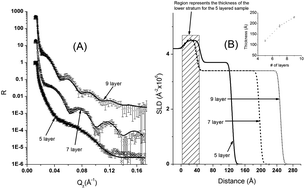Neutron reflectometry characterization of PEI–PSS polyelectrolyte multilayers for cell culture
Abstract
Using Neutron Reflectometry (NR), polyelectrolyte multilayer (PEM) films made by layer-by-layer (LbL) deposition of a strong polycation (polyethylene imine [PEI]) and a polyanion (polystyrene sulfonate [PSS]) have been characterized. PEI terminated samples with a total of 5, 7, and 9 layers were deposited on a quartz substrate and studied under three different environmental conditions (i.e., dry air, 100% relative humidity, and bulk water). We were able to model all the measurements at three different contrast conditions using one simple, physically reasonable and consistent model, which led to a firm understanding of the structure of the systems. The PEM thickness was found to vary linearly with the number of layers deposited. Thin film structures formed using the LbL method were constituted of two distinctive regions, i.e., the bottom and top strata. When measured in dry air and D2O vapors, the ∼30 to 50 Å thick bottom stratum was found to consist of loosely packed polymers (i.e. 30% polymer by volume). This region could have resulted from an island type of deposition during the initial stages of LbL assembly. In contrast, the thickness of the top strata, which consisted of densely packed polymers (i.e. 100% polymer by volume when measured in dry air), was found to vary linearly with the number of layers deposited. Upon exposure to D2O saturated vapors, it was observed that the top and bottom strata absorbed significant quantities of heavy water, accompanied with PEM swelling. We estimated that in this case, the top strata comprise ca. 57% (v/v) polymer and 43% (v/v) D2O for 7- and 9-layered samples. No further swelling of the PEM samples was observed when they were exposed to bulk D2O. Nevertheless, the entire polymeric system underwent a rearrangement leading towards the homogenization of the multilayered structure, suggested by the decreased scattering contrast between the top and bottom strata. We also performed studies to assess the cytocompatibility of 7-layered PEM structures. Two different cell types, fibroblasts (3T3) and human embryo kidney cells (HEK-293), were seeded on the polyelectrolyte multilayer, and the cell coverage was monitored by optical microscopy at varying times. Our observations confirmed that cells adhered and spread on PEM substrates, which showed no sign of immediate toxicity. Therefore, such multilayers proved to be a suitable support for 3T3 and HEK-293 cell growth.


 Please wait while we load your content...
Please wait while we load your content...